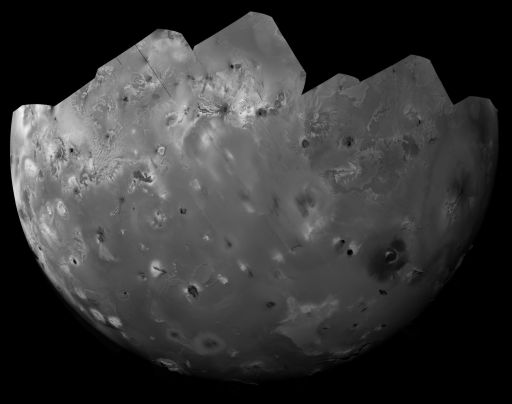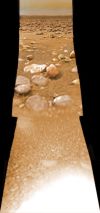Emily Lakdawalla • Mar 10, 2009
A first map of Io, revisited
On the occasion of the 30th anniversary of the Voyager 1 flyby of Jupiter's volcanic moon Io, Jason Perry has been writing a retrospective series of blog entries. But he's not just writing about history; he dug in to the Voyager 1 image archive and has reconstructed a massive, high-resolution mosaic of Io's southern hemisphere containing dozens of named volcanoes, flow features, and mountain chains. It's pretty spectacular. Here's two versions of the mosaic, one at glorious full resolution and one lower-resolution with names for all the features. It took almost an hour for Voyager 1 to shoot the 33 images that Jason assembled into this mosaic, at around 13:00 UTC on March 5, 1979.

NASA / JPL / Jason Perry
Voyager 1's mosaic of Io's southern hemisphere
This mosaic consists of 33 separate images acquired by Voyager 1 as it approached for its close flyby of Io on March 5, 1979. Because it took almost an hour to capture all the images, Voyager 1's point of view shifted throughout the imaging; the individual photos have been "reprojected," stretched and warped based on information about Voyager 1's position while capturing each image to fit a common point of view (in this case, it is an orthographic projection, in which the viewpoint is from infinity). The mosaic reveals a number of volcanic features: paterae, flow fields, tholi, and plumes, in various shapes and sizes. Paterae in the south polar region tend to be larger than those nearer to the equator, suggestive of differences in lithospheric properties and magma source regions in Io's mantle.As time passed, it became apparent that Voyager 1 had been affected by Jupiter's radiation environment. the basic timing -- the main clock on the spacecraft -- had slowed down. First it slowed by 6.3 seconds, but by March 6 it was found to have slowed a total of eight seconds. In addition, the two central computers apparently got out of synchronization both with themselves and with the flight data subsystem. On March 6 it was reported that the spacecraft cameras were shuttering at one frametime (48 seconds) early; this was partly offset by the eight-second spacecraft "masterclock" slowdown resulting in images (according to our clocks) being photographed forty seconds early. This timing error resulted in the camera taking some pictures while the scan platform was moving, causing some blurred images. A number of the highest resolution images of Io and Ganymede were seriously degraded by this malfunction. (p.75)
Rereading these accounts reminds me of the importance of initial reconnaissance missions. They don't just give us our first pretty pictures of a place, they also tell us what conditions await any followup mission. The radiation environment at Jupiter was much more problematic than the Voyager engineers had expected. The follow-on mission to Jupiter, Galileo, did famously have a problem with its antenna, but Galileo made up for its slow data transmission rates in part by coping extremely well with the hellish radiation environment, surviving plunge after plunge deep into Jupiter's energetic magnetosphere, lasting years longer than it had any right to.
There's bound to be such Monday-morning quarterbacking on all future initial reconnaissance missions. I'm sure there'll be people lamenting some missed opportunity by New Horizons at Pluto, some phenomenon we could have learned so much about if only they'd sequenced such-and-such an observation to take place of such-and-such a location. When Dawn arrives at Vesta, another world that's never been explored up close, it will at least have the luxury of being in orbit, so some of the science observation plans could presumably be changed if they discover something really unexpected (for example, a tiny moon), but what they can't change is the suite of scientific instruments they brought with them. Just remember that if we knew exactly what to expect at all of these locations, we wouldn't need to explore them in the first place!
Support our core enterprises
Your support powers our mission to explore worlds, find life, and defend Earth. You make all the difference when you make a gift. Give today!
Donate

 Explore Worlds
Explore Worlds Find Life
Find Life Defend Earth
Defend Earth



